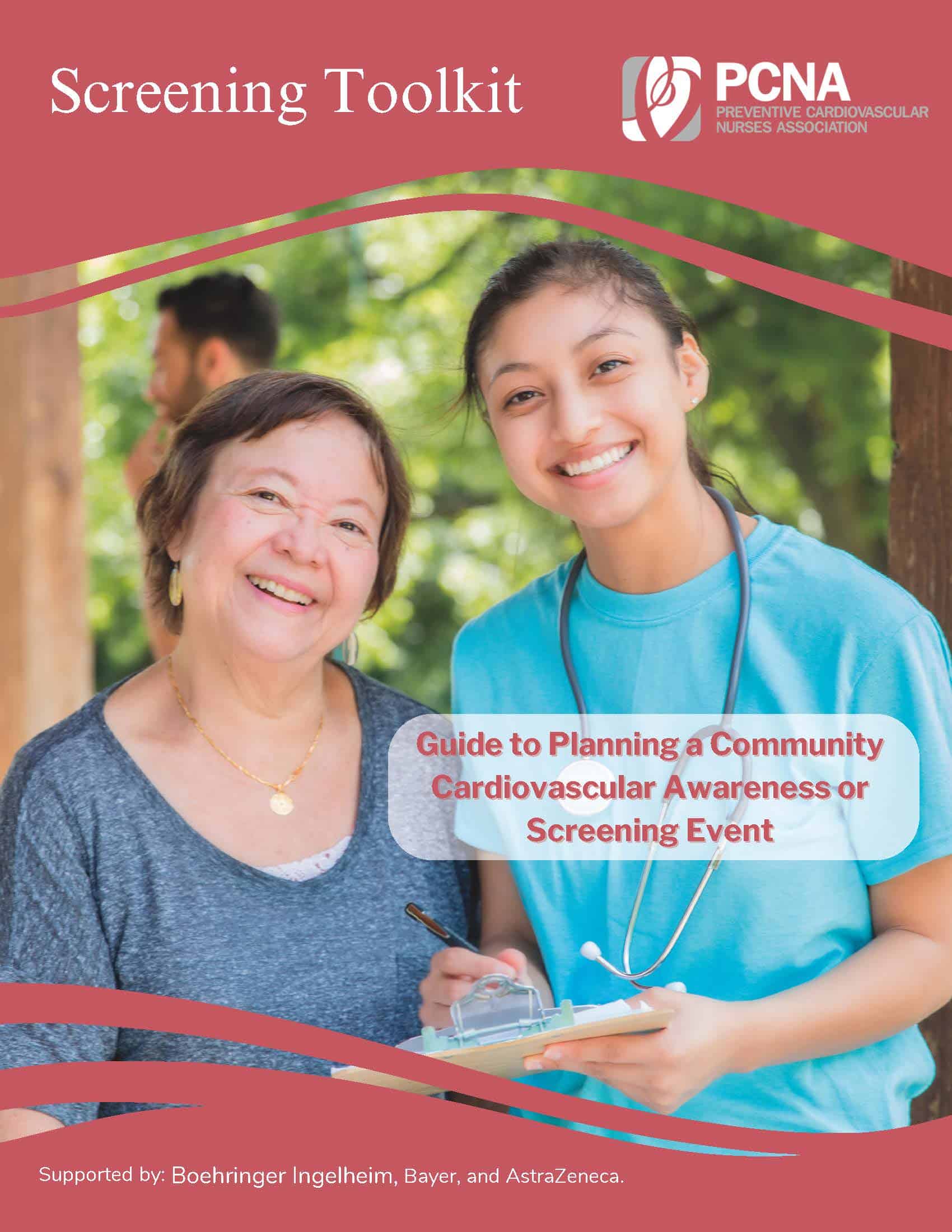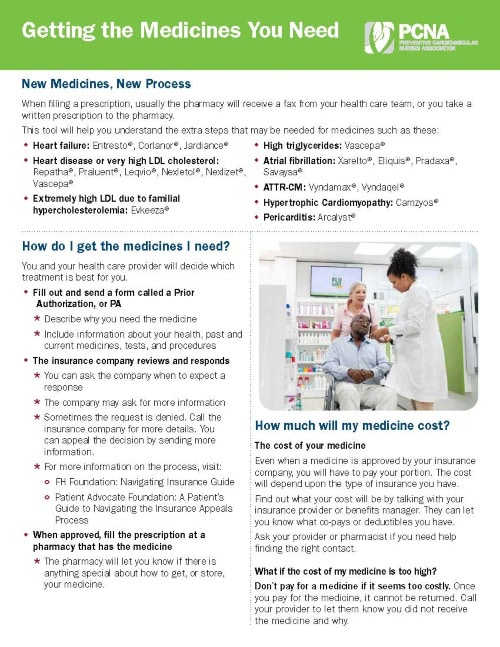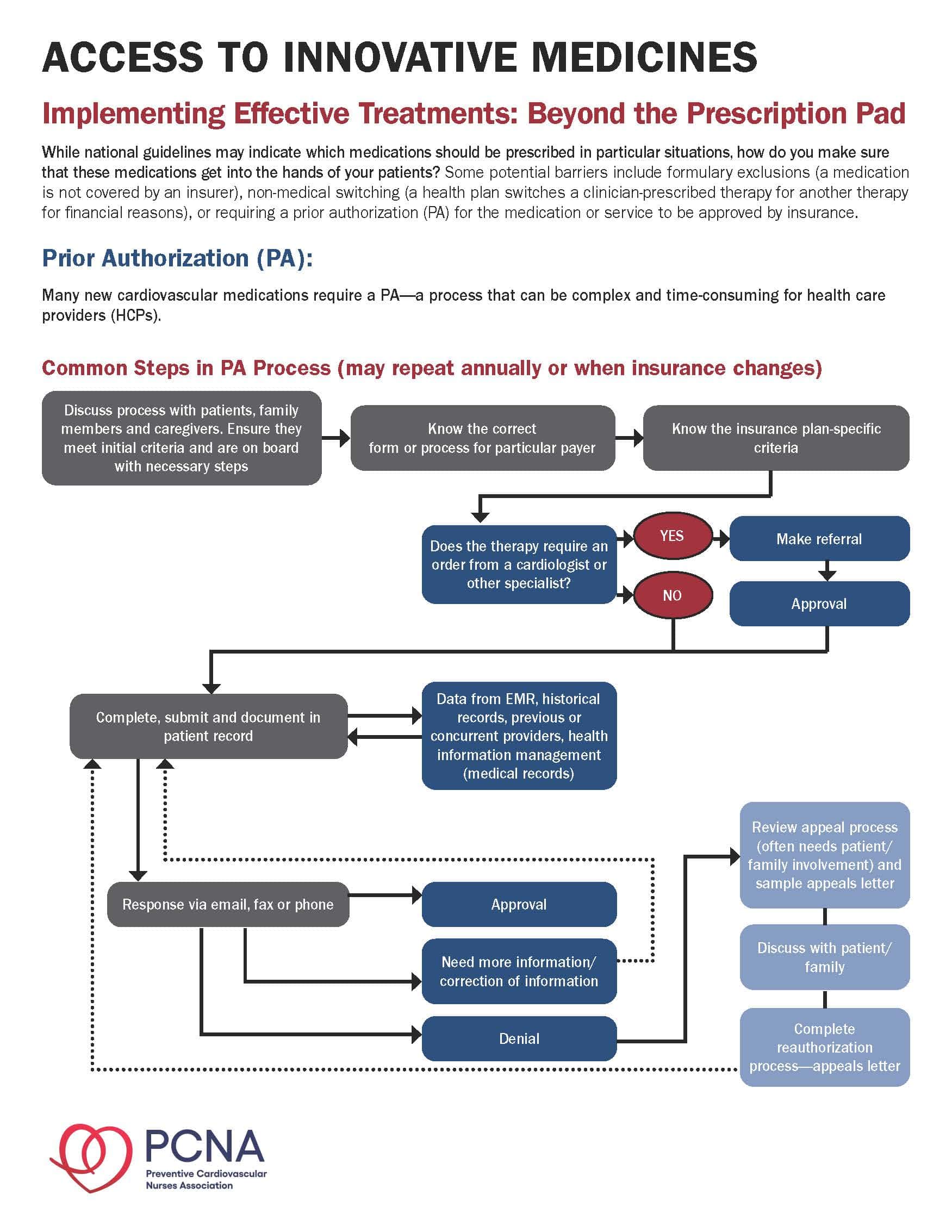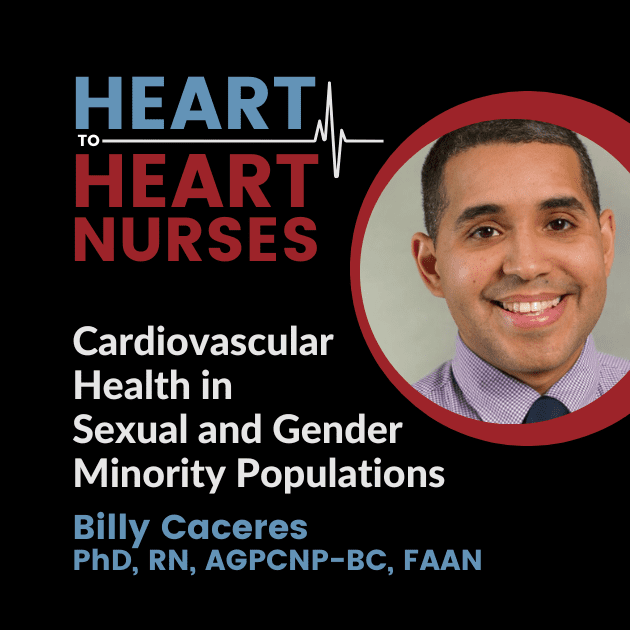Sexual and gender minorities–those identified as LGBQT+–are at increased risk of cardiovascular disease. Investigate the connections between heart health and minority stressors, poverty, care delays or avoidance, discrimination, and other factors affecting our patients, and how nurses can positively impact care and outcomes. Guest: Billy Caceres, PhD, RN, AGPCNC-BC, FAAN, of Columbia University.
Episode Resources
Welcome to Heart to Heart Nurses, brought to you by the Preventive Cardiovascular Nurses Association. PCNA’s mission is to promote nurses as leaders in cardiovascular disease prevention and management.
Geralyn Warfield (host): We are so honored today to have Dr. Billy Caceres with us today, talking about LGBTQ+ populations and the intersection of cardiovascular disease and the needs that these populations might have. Dr. Caceres, would you be interested in sharing a little bit about yourself with our audience?
Billy Caceres (guest): Sure. Thank you for having me today. So, I’m an Assistant Professor at Columbia University at the School of Nursing, in the Center for Sexual and Gender Minority Health Research. And I study [00:01:00] cardiovascular disease disparities in sexual and gender minority adults, which is just another name or term that’s used to identify lesbian, gay, bisexual, transgender, queer people, or LGBTQ people.
Geralyn Warfield (host): Well, we are so grateful to you for spending time with us today, and I’m hoping that you can get started by talking a little bit about the factors that contribute to the increased risk of cardiovascular disease among sexual and gender minority populations.
Billy Caceres (guest): Sure. So, there are a number of factors that are thought to contribute to cardiovascular health disparities in sexual and gender minority populations. A lot of them have not been tested in research studies, but what we know from other populations, we can sort of surmise or guess that they probably exert a similar influence on the cardiovascular health of sexual and gender minority individuals.
So, sort of the prevailing theory or explanation for cardiovascular health disparities and sexual and gender minority populations is that they experience what we call greater minority stressors. And minority stressors are [00:02:00] sort of these unique experiences that somebody experiences because of their minority sexual orientation or gender identity. So, for instance, somebody who identifies as transgender has to deal with the unique stressor or experience of having to actually come out to their family as transgender, which is not really an experience that somebody in the general population would have to go through.
So, the idea is that these minority stressors, which could include things like being afraid of being rejected, experiences of discrimination, that these stressors are on top of all of the other stressors that we experience as human beings living in society, things like work stress, family stress, that these stressors are more compounded in sexual and gender minority people.
So, in addition to that, there is more and more evidence showing that sexual and gender minority populations, particularly bisexual and transgender men and women, are much more likely to live in poverty than people who are non-sexual, sexual and gender [00:03:00] minorities. And even within LGBTQ people, we see that people of color—Black, Latino, American Indian—are about two times more likely to live, to live in poverty than even white sexual and gender minority individuals. So, poverty is another sort of factor that we think contributes to these disparities. And that’s sort of related to the next factor, which is lower access and use of healthcare services.
So, there’s a lot of evidence to show that bisexual women and transgender individuals are much more likely to delay seeking needed healthcare services. And that’s often due to cost concerns. They’re afraid that they can’t pay for it, but it also is due to other things like they can’t take off of work to go, to go see a provider, or they didn’t have proper transportation to be able to make it to a certain provider, if it’s out of the way. And then related to sort of healthcare utilization is the fact that there is research to show that about 70% of transgender people have been discriminated against by a healthcare provider, about 50% of lesbian, gay, and bisexual [00:04:00] people report being discriminated against by a healthcare provider.
So, we, it’s easy to see why LGBTQ people might delay seeking care or might avoid seeking care until they really need to in an emergency. But what that does is that it has implications for the identification and management of chronic conditions like hypertension and diabetes, which influence heart disease risk.
So, those are sort of the main factors. Some additional factors that have been shown to influence cardiovascular health in the general population are things like exposure to violence, like exposure to sexual and physical abuse, has been shown to increase risk for heart disease, hypertension, diabetes, obesity, in the general population.
And what we see in sexual and gender minority adults is that they are much more likely to report experiencing things like sexual and physical abuse, both in adulthood and in childhood compared to non-sexual and gender minority [00:05:00] individuals. So, altogether, these sort of create these circumstances where LGBTQ people just, have different experiences that may place them at a greater risk for heart disease.
Yeah. And there’s the one thing that I’ll say is that there’s very little research that’s actually tried to link these sort of social determinants that I discussed, minority stress, poverty, healthcare utilization, with cardiovascular health in sexual and gender minority adults. But some of the work that we’ve done at Columbia has really shown that things like childhood physical and sexual abuse, and adulthood physical and sexual abuse, are associated with higher rates of obesity and hypertension among lesbian and bisexual women. There’s some other research that indicates that discrimination is associated with higher prevalence of tobacco use among certain sexual and gender minority individuals.
So, there is sort of this small, but growing, body of research, it’s now really trying to link the things that [00:06:00] we think influence their cardiovascular health with actual cardiovascular health outcomes. So, it’s sort of a really exciting time to be doing this type of work.
Geralyn Warfield (host): We are talking today with Dr. Billy Caceres about cardiovascular disease among sexual and gender minority populations. We’re going to take a brief break and be right back.
Geralyn Warfield (host): We’re back with Dr. Billy Caceres, speaking about cardiovascular health and the special issues that relate to individuals who are sexual and gender minority populations. And Dr. Caceres, if we could segue for our audience into what nurses can do, in terms of strategies that they might utilize to promote cardiovascular health in these populations.
Billy Caceres (guest): It’s an excellent question. So, when I think of the role of nurses, I always think of it as sort of multifactorial and quite complex. So, I think as nurses, we generally are thought of in terms of clinical practice, but I think we also have a role in promoting nursing education. We have a role in policy. We have a role in promoting research.
So, when [00:07:00] I think of strategies, I often think of them in those four categories: education, clinical practice, policy, and research. So, I think there’s some strategies for each of those. I’m going to highlight a few of them today.
So, in terms of clinical practice, there are certain things that practicing cardiovascular nurses can do to sort of promote the cardiovascular health and the well-being of sexual and gender minority individuals. Some of it includes accessing different educational resources to learn more about the needs of the population, sort of what are the pressing health issues in the population?
Also, some training around the proper way of assessing someone’s sexual orientation or gender identity in clinical practice. So, in the year, I think it was 2015, the Obama administration passed a law that made it so that all electronic health record systems must have the capability of assessing sexual orientation and gender identity.
[00:08:00] So, for any nurse that’s practicing, most nurses now are probably, have access to, or expected to, assess sexual orientation and gender identity in certain clinical encounters. But what I think the big issue is that we often don’t provide nurses with the proper training to be able to do that. And I think that’s a really big gap, and nurse, practicing nurses really can do a lot to sort of move their institutions to ensure that they receive the proper training that they need to actually care for sexual and gender minority individuals.
And one aspect of that is how do you assess for sexual orientation and gender identity? But another aspect of that is also understanding, for transgender individuals, like how do you ask somebody what their preferred pronouns are? How do you refer to someone? What are all these different gender identity terms? What does gender nonbinary mean? What does gender nonconforming mean? What does agender mean? So, really sort of like basic training on the pressing health issues, some terminology would be really helpful for clinical nurses that are practicing currently.[00:09:00]
I think that the same could be said for nurses that we’re now training in Bachelors and Associates programs throughout the country, that they really, what we’ve seen in the literature is that nursing programs really dedicate at most, maybe five hours to sexual and gender minority health content during the scope of an undergraduate program. And that really that content tends to focus on HIV and sexual health without really thinking about all the other health issues that are important for this population. And it like, like cardiovascular disease, but also things like depression, anxiety, suicidal ideation.
And it’s really important that we sort of infuse more sexual and gender minority health content in nursing curricula so that the students that we’re graduating have sort of a leg up, and they sort of have a better understanding of how do you actually care for these populations in a manner that is affirming, that isn’t ‘otherizing’ them. And that really sort of meets patients where they’re at, which I think is really important.
And then in terms of [00:10:00] research, there’s really so many different research gaps. That, one of them that I discussed, was this idea of, well, we think the social factors, social determinants, influence the cardiovascular health of sexual and gender minority people. But we don’t really know if they actually do. We haven’t comprehensively tested that. So, I think there’s really big opportunities in research to actually try to better understand like, well, how does somebody’s exposure to discrimination contribute to their hypertension? That’s great. That’s sort of this unanswered question that still exists.
I think another big thing that’s super important is we have no evidence-based interventions for cardiovascular risk reduction that are tailored to sexual and gender minority people. We have some for other minority groups like Black and Latinx people, but we really don’t have anything sort of similar, that’s been robustly tested, for cardiovascular risk reduction in sexual and gender minority adults. So, I think that’s a really important area for research, sort of thinking about what are the things that need [00:11:00] to be addressed in an intervention for to improve the cardiovascular health of sexual and gender minority adults.
And then last, I think the big thing is policy. And oftentimes when I talk about policy, this happens when I talk about policy to graduate students, what I often hear is, “Well, I don’t like being involved in policy because it’s too political.” And there’s the sense that, if you have an opinion about a policy that it’s political, but it is political, right?
If you have an opinion about certain health services that should be universal, or access to a particular type of care that a certain population needs, that’s all regulated by policy. So, in essence, you have to have a political opinion because of that. And I think that oftentimes we shy away, as nurses, from actually having a political opinion, but I think, when I always think of it is when we’re advocating for policies, it’s always about what does the research evidence show us? What does the research evidence show that’s effective and that will work for different [00:12:00] populations? And I think the same is true for cardiovascular health.
I think we, as nurses, play a big role. We have so many lar…we’re the largest healthcare profession. We have so many nursing organizations that do a lot of advocacy, and policy work, and lobbying, that we really need to sort of harness that power to really bring about change for the communities that we care about. But I think oftentimes what happens with sexual and gender minority populations is that the focus is on policies that are specific to the population.
So, for instance, same-sex marriage became legalized at the federal level in 2015. And a lot of people thought, well, this is going to fix all of the LGBTQ health disparities that we see, but that’s really one component of their social, sort of, their social life, right? That we still have policies in which LGBTQ people can be discriminated against in restaurants, or police stations, like what we call public accommodations.
And the bigger thing really is thinking about access to healthcare and income equality. We know that LGBTQ people are more [00:13:00] likely to not access the needed health services, like I said before. And they’re more likely to live in poverty. So, really any policies that are enacted in society to sort of bridge the gap in income inequalities, and increased care, or access to care for people, even if it’s not a specific policy for LGBTQ people, it is going to have a disproportionately beneficial effect on LGBTQ people and other marginalized populations that experience health disparities.
So, I think it’s really important that we think sort of beyond the LGBTQ-specific things, which are important. And I’m not saying we shouldn’t advocate for LGBTQ-inclusive policies, but I think that we could do more to advocate for other types of policies that would disproportionately benefit these populations.
Geralyn Warfield (host): You have given us so much information for us to digest, and take to heart, and take action on, whether that’s through something that we’re doing in our individual clinical practices, whether we’re doing some advocacy work. [00:14:00] Is there anything that you would suggest to our audience to get more involved or find more information? Any resources you might suggest?
Billy Caceres (guest): Yeah. So, there are a number of resources and I think that’s, what’s great now, I can’t say the same thing, maybe 10 years ago; it was not as extensive (the resources for sexual gender minority health), but there’s a number of organizations that have trainings and resources for nurses.
So, one of them is the Gay and Lesbian Medical Association, has actually prints out, or they publish a handbook for how to provide inclusive care for LGBTQ people that people can access online. I think it’s a book that you can purchase, but it’s sort of created by this interdisciplinary group of providers that care about, and care about the needs of LGBTQ people.
The Gay and Lesbian Medical Association also has a wonderful resource, a provider directory of providers that they’ve sort of vetted, that are LGBTQ-affirming providers. So, if you’re in [00:15:00] an area that doesn’t have a lot of psychotherapists or even psychiatric nurse practitioners that have expertise in LGBTQ health, you can actually go on the website for the Gay and Lesbian Medical Association and try to find a provider to link your patient with the types of services that they would really like. That’s one resource.
Through the national LGBTQIA+ education center, there are dozens of free modules, these continuing education modules, on a number of different topics related to sexual gender and minority health, anything from transgender, transgender care, gender-affirming hormone therapies, the care of LGBTQ older adults, a number of different resources that I think nurses can really access and potentially even use in, in educating their nursing students. Assign some of the modules to their students, I think would provide a good introduction to LGBTQ health.
So, there’s a number of resources. And of course, local LGBTQ organizations are happy to partner with nurses to do a health fair, [00:16:00] a blood pressure screening, a session where they have a nurse who comes and talks about the importance of, I don’t know, having a healthy diet.
So, I think that there is a lot of, sort of, openness from the community. So, they have for so long, been an underserved and under-studied population, that I think there’s a real sort of like hunger to have access to these resources from trusted healthcare providers and who better to provide that than nurses?
Geralyn Warfield (host): Well, we’ve been speaking with Dr. Billy Caceres, and we look forward to learning more, and thank you so very much for being with us today. This is your host, Geralyn Warfield, and we will see you next time.
Thank you for listening to Heart to Heart Nurses. We invite you to visit pcna.net for clinical resources, [00:17:00] continuing education, and much more.
Topics
- Global Perspectives
- Health Equity
- Professional Development
Published on
August 30, 2022
Listen on:
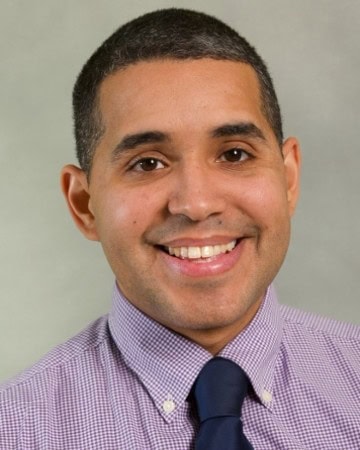
PhD, MSN, BSN, BA, FAAN, FAHA
Related Resources
